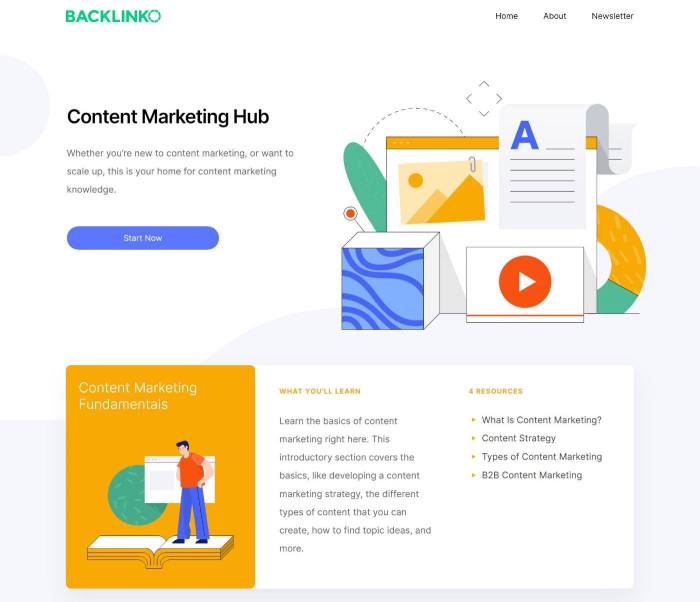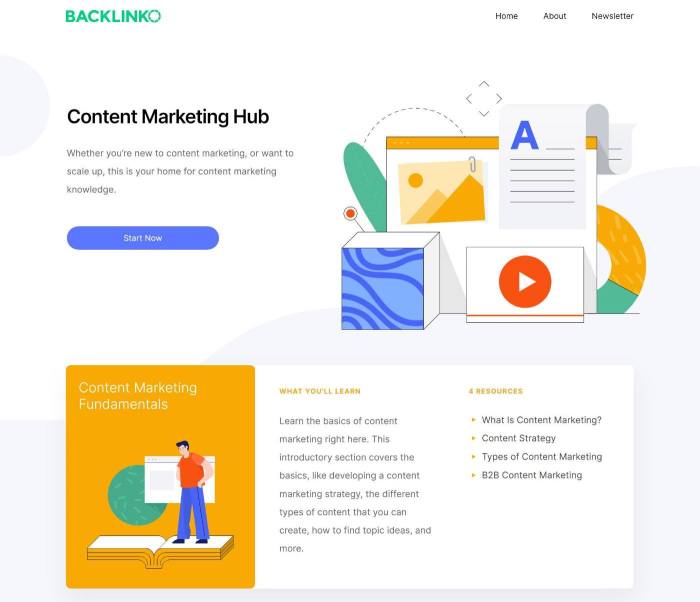Launching a Content Hub sets the stage for a digital journey filled with creativity and innovation, where businesses thrive and engage with their audience in unique ways. Dive into the world of content hubs and discover the secrets to success!
From planning to promotion, this comprehensive guide covers every aspect of creating and managing a content hub that leaves a lasting impact on your target audience.
Introduction to Content Hub: Launching A Content Hub
A content hub is a centralized platform where businesses can create, organize, and distribute valuable content to their target audience. It serves as a one-stop destination for all the information and resources related to a company’s products or services.
Examples of Successful Content Hubs
Some successful examples of content hubs include:
- HubSpot: HubSpot’s content hub consists of a blog, resource center, and a multimedia library that offers valuable insights and resources for marketers and businesses.
- Red Bull Media House: Red Bull’s content hub features extreme sports videos, articles, and interviews that engage their audience and promote their brand lifestyle.
- Salesforce Trailhead: Salesforce’s content hub provides interactive tutorials, guides, and certifications to educate users about their products and services.
Key Components of a Content Hub
A successful content hub typically includes the following key components:
- Blog: Regularly updated with informative articles and insights to attract and engage the audience.
- Resource Center: A collection of ebooks, whitepapers, guides, and case studies that provide in-depth information and solutions to the audience’s problems.
- Multimedia Library: Videos, podcasts, infographics, and other visual content to enhance user experience and convey information in a more engaging manner.
Planning and Strategy

When it comes to planning and launching a content hub, there are several crucial steps to consider in order to ensure its success.
Defining Target Audience and Content Goals
One of the most important steps in planning a content hub is defining your target audience and content goals. This involves understanding who your audience is, what they are interested in, and what kind of content will resonate with them. By clearly defining your target audience and content goals, you can create content that is tailored to their needs and interests, increasing engagement and driving results.
- Research your target audience: Conduct thorough research to understand the demographics, preferences, and behaviors of your target audience.
- Set clear content goals: Define specific and measurable goals for your content hub, whether it’s increasing brand awareness, driving website traffic, or generating leads.
- Create audience personas: Develop detailed audience personas to better target your content and ensure it meets the needs of your audience.
Aligning with Marketing and Business Objectives, Launching a Content Hub
Aligning your content hub with overall marketing and business objectives is essential to ensure that it contributes to the success of your organization.
- Understand marketing objectives: Work closely with your marketing team to align the content hub with the broader marketing strategy and objectives.
- Integrate with business goals: Ensure that the content hub supports the overall business goals and contributes to the bottom line.
- Measure and analyze results: Regularly track and analyze the performance of the content hub to ensure it is meeting its objectives and driving results.
Content Creation and Curation
Creating killer content for your hub is crucial to keep your audience engaged and coming back for more. Here are some tips to ensure your content stands out from the rest:
High-Quality Content Tips
- Research your audience: Understand who you’re creating content for to tailor your message accordingly.
- Unique perspective: Offer a fresh take on popular topics to differentiate your content from competitors.
- Visual appeal: Incorporate eye-catching graphics and multimedia elements to enhance the overall look and feel.
- Consistent voice: Develop a unique tone and style that resonates with your audience and sets your content apart.
- optimization: Use relevant s and meta tags to improve search engine visibility and drive organic traffic.
Content curation plays a vital role in keeping your hub updated with the latest trends and information, without having to create everything from scratch. Here’s how you can use content curation effectively:
Role of Content Curation
- Stay informed: Regularly scan industry news and reputable sources to identify relevant content for your audience.
- Provide value: Curate content that adds value to your audience’s lives, whether it’s informative, entertaining, or inspiring.
- Credit the source: Always give credit to the original creator when sharing curated content to maintain trust and credibility.
- Engage with your audience: Encourage discussions around curated content to foster community engagement and interaction.
To maintain a consistent content schedule, it’s important to plan ahead and stay organized. Here are some strategies to help you stay on track:
Consistent Content Schedule Strategies
- Create a content calendar: Artikel your content topics, publishing dates, and promotion strategies to stay organized.
- Batch create content: Dedicate time to create multiple pieces of content in one sitting to ensure a consistent output.
- Repurpose existing content: Update and repurpose older content to breathe new life into your hub and save time on creation.
- Collaborate with others: Partner with guest contributors or influencers to diversify your content and reach a wider audience.
Design and User Experience

User-friendly design is crucial in a content hub as it directly impacts the overall user experience. A well-designed content hub enhances readability, accessibility, and engagement, leading to increased user satisfaction and retention.
Organizing Content and Improving Navigation
Organizing content in a clear and structured manner is essential for easy navigation and seamless user experience. Best practices include:
- Creating categories and subcategories to group related content.
- Implementing a search function for users to easily find specific topics.
- Using clear and intuitive navigation menus for easy access to different sections of the content hub.
- Utilizing breadcrumbs to show users their current location within the content hub.
Optimizing for Different Devices and Screen Sizes
To ensure optimal user experience across various devices and screen sizes, consider the following:
- Implement responsive design to adapt the content hub layout to different screen sizes.
- Optimize images and multimedia for fast loading times on mobile devices.
- Prioritize mobile-first design to cater to the increasing number of users accessing content via smartphones and tablets.
- Ensure all interactive elements are touch-friendly for mobile users.
Promotion and Distribution
Promoting a content hub is crucial for increasing visibility and driving traffic. Utilizing various strategies and distribution channels can help reach a wider audience and maximize engagement.
Strategy
Implementing strong practices is essential for driving organic traffic to the content hub. By optimizing s, meta descriptions, and tags, you can improve search engine rankings and attract more visitors. Regularly updating content and building backlinks from reputable sites can also boost visibility.
Social Media Promotion
Utilize social media platforms to promote the content hub and engage with the audience. Share updates, articles, and other relevant content to drive traffic back to the hub. Encourage followers to like, comment, and share posts to increase visibility and reach a larger audience.
Email Marketing Campaigns
Implement email marketing campaigns to promote new content and drive traffic to the hub. Segment your email list based on interests and preferences to deliver personalized content that resonates with the audience. Include CTAs and links to the hub to encourage readers to explore further.
Collaborations and Partnerships
Collaborate with influencers, industry experts, and other brands to expand your reach and promote the content hub. Guest posting, co-hosted webinars, and cross-promotional campaigns can help drive traffic and increase visibility. Partnering with like-minded brands can also help attract a new audience.
Paid Advertising
Consider investing in paid advertising to promote the content hub and reach a targeted audience. Utilize platforms like Google Ads, social media ads, and sponsored content to increase visibility and drive traffic. Monitor and analyze ad performance to optimize campaigns and maximize results.
Measurement and Optimization
In order to ensure the success of your content hub, it is crucial to track key metrics that can provide valuable insights into its performance. By measuring various aspects of user engagement and analyzing the data, you can optimize your content hub for better results.
Tracking Key Metrics
- One important metric to track is the number of unique visitors to your content hub. This can give you an idea of how many people are accessing your content.
- Another key metric is the time spent on the content hub by each visitor. This can indicate the level of engagement with your content.
- Monitoring the bounce rate is also essential to understand how many visitors leave the content hub without interacting further.
Analyzing User Engagement
- Utilize tools like Google Analytics to track user behavior on your content hub. Analyze page views, click-through rates, and conversion rates to gain insights.
- Engage with your audience through surveys or feedback forms to understand their preferences and improve user experience.
- Monitor social media metrics to see how your content is being shared and discussed online.
Optimizing Content Hub
- Based on the performance data, identify which content performs well and optimize it further. This could involve updating or repurposing high-performing content.
- Experiment with different types of content, formats, and posting schedules to see what resonates best with your audience.
- Continuously test and refine your content strategy based on the data collected to improve the overall performance of your content hub.
